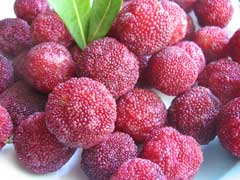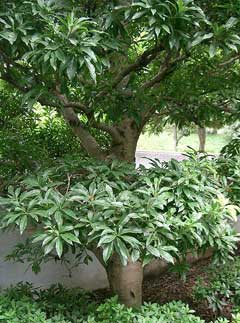 |
|
http://www.flickr.com/photos/zeping/ |
 |
| http://commons.wikimedia.org/wiki/User:KENPEI |
Translate this page:
Summary
Physical Characteristics

 Myrica rubra is an evergreen Shrub growing to 15 m (49ft 3in).
Myrica rubra is an evergreen Shrub growing to 15 m (49ft 3in).
See above for USDA hardiness. It is hardy to UK zone 10. It is in leaf all year. The species is monoecious (individual flowers are either male or female, but both sexes can be found on the same plant) and is pollinated by Wind.
It can fix Nitrogen.
Suitable for: light (sandy), medium (loamy) and heavy (clay) soils and prefers well-drained soil. Suitable pH: mildly acid and neutral soils. It can grow in semi-shade (light woodland) or no shade. It prefers moist soil.
UK Hardiness Map
US Hardiness Map
Synonyms
M. nagi. non Thunb.
Plant Habitats
Woodland Garden Sunny Edge; South Wall. By. West Wall. By.
Edible Uses
Edible Parts: Fruit Seed
Edible Uses:
Fruit - raw or cooked[1, 105]. Succulent and aromatic[82], it has an agreeable sub-acid taste[183]. Juicy, sweetish and sour according to another report[174]. The fruit soon rots so it is difficult to grow commercially because of the problems of getting it to market in good condition[174]. The fruit is up to 25mm in diameter[200]. The seed is said to be edible[61, 177, 183].
References More on Edible Uses
Medicinal Uses
Plants For A Future can not take any responsibility for any adverse effects from the use of plants. Always seek advice from a professional before using a plant medicinally.
Astringent Cardiac Carminative Cholera Pectoral Skin Stomachic Vulnerary
Astringent, carminative, vulnerary[174, 178]. The stem bark is used as a wash in the treatment of arsenic poisoning, skin diseases, wounds and ulcers[218]. The fruit is carminative, pectoral and stomachic[218]. The seed is used in the treatment of sweaty feet[218]. The plant is used in the treatment of cholera, heart ailments and stomach diseases[218].
References More on Medicinal Uses
The Bookshop: Edible Plant Books
Our Latest books on Perennial Plants For Food Forests and Permaculture Gardens in paperback or digital formats.

Edible Tropical Plants
Food Forest Plants for Hotter Conditions: 250+ Plants For Tropical Food Forests & Permaculture Gardens.
More

Edible Temperate Plants
Plants for Your Food Forest: 500 Plants for Temperate Food Forests & Permaculture Gardens.
More

More Books
PFAF have eight books available in paperback and digital formats. Browse the shop for more information.
Shop Now
Other Uses
Dye
A yellow dye is obtained from the plant[174]. (The part of the plant is not specified). Nitrogen Fixer.
Special Uses
Food Forest Nitrogen Fixer
References More on Other Uses
Cultivation details
Prefers a moist soil. Grows well in an open position in a well-drained soil in sun or light shade[200]. Thrives in any ordinary garden soil[11]. Prefers a lime-free loamy or peaty soil[1]. Not very hardy in Britain, it succeeds outdoors in the milder areas of the country according to one report[1], whilst another says that it only succeeds in zone 10 and does not tolerate frosts[200]. Plants succeed outdoors in Japan as far north as Tokyo, but it is difficult to get them to fruit there[174].. This plant has been recommended for improvement by selection and breeding for its edible fruit. Plants in this genus are notably resistant to honey fungus[200]. Many species in this genus have a symbiotic relationship with certain soil micro-organisms, these form nodules on the roots of the plants and fix atmospheric nitrogen. Some of this nitrogen is utilized by the growing plant but some can also be used by other plants growing nearby[200].
References Carbon Farming Information and Carbon Sequestration Information
Temperature Converter
Type a value in the Celsius field to convert the value to Fahrenheit:
Fahrenheit:
The PFAF Bookshop
Plants For A Future have a number of books available in paperback and digital form. Book titles include Edible Plants, Edible Perennials, Edible Trees,Edible Shrubs, Woodland Gardening, and Temperate Food Forest Plants. Our new book is Food Forest Plants For Hotter Conditions (Tropical and Sub-Tropical).
Shop Now
Plant Propagation
Seed - best sown as soon as it is ripe in the autumn in a cold frame. Barely cover the seed and keep it moist. Stored seed germinates more freely if given a 3 month cold stratification and then sown in a cold frame. Germination is usually good[78]. Prick out the seedlings into individual pots when they are large enough to handle and grow on in the cold frame for the first winter. Plant out in late spring or early summer[K]. Cuttings of half-ripe wood, 5 - 8cm with a heel, July/August in a frame. Pot up and overwinter in a cold frame. Fair to good percentage[78]. Cuttings of mature wood in November/December in a frame. Layering in spring[200]. Division of suckers in the dormant season. Plant them out direct into their permanent positions.
Other Names
If available other names are mentioned here
Native Range
TEMPERATE ASIA: Fujian Sheng, Guangdong Sheng, Guangxi Zhuangzu Zizhiqu, Guizhou Sheng, Honshu (south), Hunan Sheng, Japan, Jiangsu Sheng, Jiangxi Sheng, Korea, Kyushu, Ryukyu Islands, Shikoku, Sichuan Sheng, South, Taiwan, Yunnan Sheng, Zhejiang Sheng,China. TROPICAL ASIA: Philippines,
Weed Potential
Right plant wrong place. We are currently updating this section.
Please note that a plant may be invasive in one area but may not in your area so it's worth checking.
Conservation Status
IUCN Red List of Threatened Plants Status :

Growth: S = slow M = medium F = fast. Soil: L = light (sandy) M = medium H = heavy (clay). pH: A = acid N = neutral B = basic (alkaline). Shade: F = full shade S = semi-shade N = no shade. Moisture: D = dry M = Moist We = wet Wa = water.
Now available:
Food Forest Plants for Mediterranean Conditions
350+ Perennial Plants For Mediterranean and Drier Food Forests and Permaculture Gardens.
[Paperback and eBook]
This is the third in Plants For A Future's series of plant guides for food forests tailored to
specific climate zones. Following volumes on temperate and tropical ecosystems, this book focuses
on species suited to Mediterranean conditions—regions with hot, dry summers and cool, wet winters,
often facing the added challenge of climate change.
Read More
Expert comment
Author
(Lour.)Siebold.&Zucc.
Botanical References
58200266
Links / References
For a list of references used on this page please go here
Readers comment